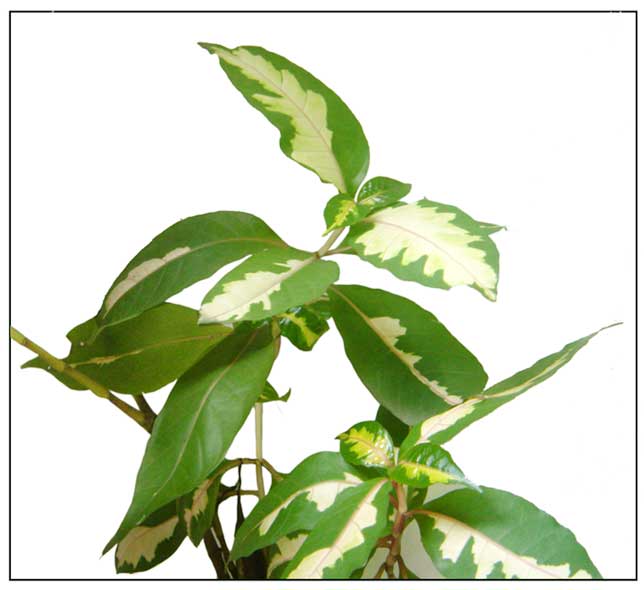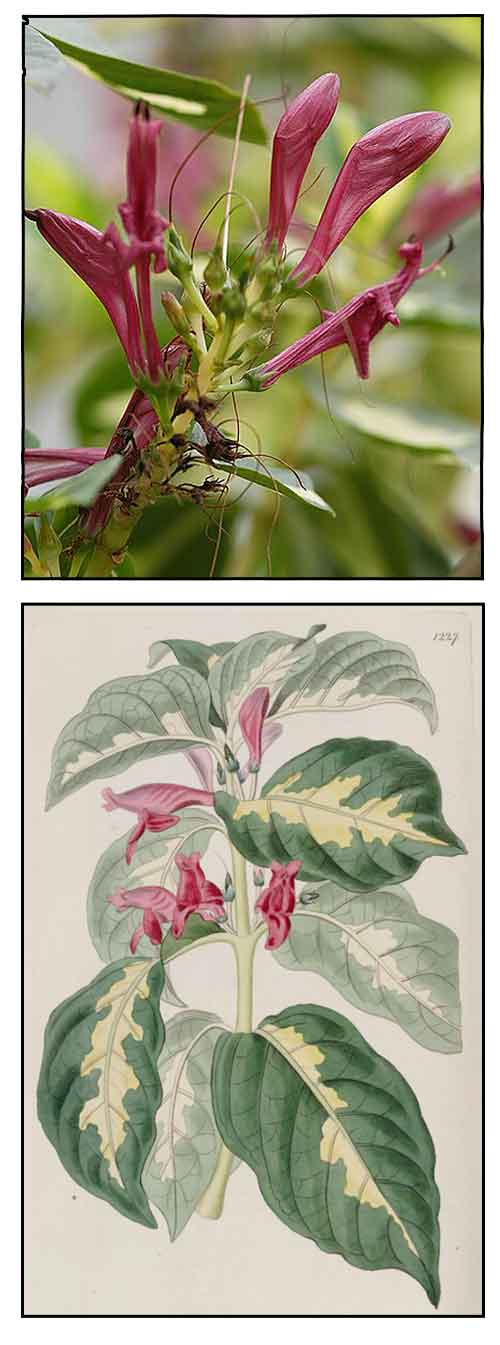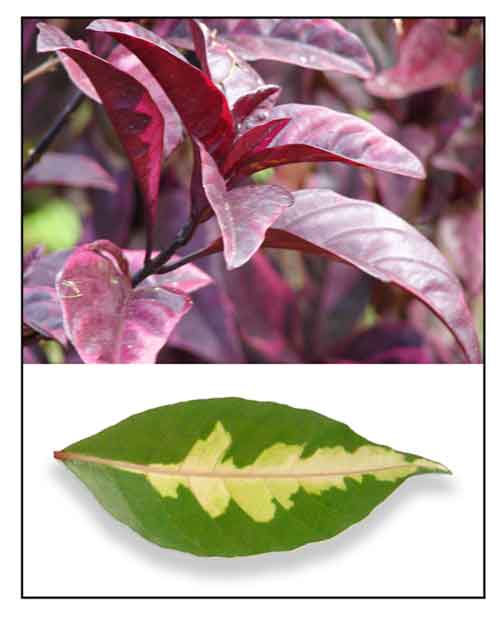 Gen info Gen info
- Acanthaceae is a family of dicotyledonous flowering plants containing almost 250 genera and about 2500 species. As of December 2021, GRIN (Germplasm Resources Information Network) accepts 217 genera. As of January 2024, Plants of the World Online lists 207 genera.
(31)
-
Graptophyllum pictum is a shrub in the family Acanthaceae. It is native to New Guinea.
- There are two varieties: the variegated color known as the "white adulsa," and the dark-leaved variety, the "black adulsa."
- Etymology: the genus name Graptophyllum derives from Greek word graptos "inscribed" and Latin word for leaf "phyllon" - Specific epithet pictum derives from Latin pictus, meaning "colored", referring to the colorful leaves in the species that appear painted. (16)
Botany
• Kalpueng is an erect, smooth and branched shrub
growing up to 3.5 meters in height. Leaves are opposite, oblong to broadly
ellliptic, 10 to 20 centimeters long, purplish or green splotched with light yellow
or orange, narrow and pointed at both ends, with entire margins. Flowers
are large, generally dark purple or reddish purple color, about 4 centimeters long,
and borne in terminal, erect racemes, 6 to 12 centimeters long. Corolla throat
is compressed.
• Shrubs to 3 m tall; stems glabrous. Leaves ovate to elliptic, to 20 cm long, 9 cm wide, apically acuminate, basally attenuate, glabrous, purplish or green, variously marked with yellow, the margins entire; petioles short. Inflorescences in terminal racemes, the rachis glabrous or sparingly puberulous; corollas dark purple or crimson, glabrous outside, glandular puberulous inside, to ca. 8 cm long, 1.5 cm broad at the mouth; stamens 2, exserted, staminodes 2. Capsule clavate; seeds 2-4. (Flora de Panama)
 Distribution
Distribution
- Introduced.
- Not naturalized.
- Ornamental cultivation.
- Occurring in two forms in the Philippines: Green leaves blotched in
white, the other, with dark purple leaves.
-
Widely planted as a hedge.
- Native to New Guinea.
Constituents
- Preliminary phytochemical screening of petroleum ether and ethanolic extracts of aerial parts yielded alkaloids, flavonoids, tannins, glycosides, saponins, and steroids as organic constituents. Analysis of various inorganic elements yielded calcium, iron, sulfate, phosphates and chlorides. (14)
- Study of methanol extract of leaves indicated presence of alkaloids, flavonoid, and terpenoids, with total phenolic and total flavonoid content of 41.17 mg GAE/g and 26.52 mg QE/gm respectively. (17)
-
GC-MS analysis of methanol extract of leaves revealed several active compounds, including eicosane, 2,4-Di-tert-butylphenol, hentriacontane, tetracosane, octacosane, sulfurous acid, 2-methylhexacosane, docosane, heneicosane, 1-propene-1,2,3-tricarboxylic acid, tributyl ester, and pentacosane. (see study below) (17)
- Study of aerial parts isolated seven compounds, including three furanolabdane diterpenoids, i.e., Hypopurin E, Hypopurin A and Hypopurin B, as well as with Lupeol, β-sitosterol 3-O-β-d-glucopyranoside, stigmasterol 3-O-β-d-glucopyranoside and a mixture of β-sitosterol and stigmasterol. (see study below) (25)
Properties
- Distilled leaves emit a scent of coumarin.
- Considered diuretic, emollient, resolvent.
- Studies have suggested anti-inflammatory, analgesic, anti-diabetic, oxytocic, anti-implantation, anti-plaque forming, estrogenic, anti-hemorrhoidal, nephroprotective, anticholinesterase, anticancer, anticariogenic properties.
Parts
used
Leaves, juice, flowers.
Uses
Folkloric
• Used in folklore medicine to enhance fertility, as poultice on cuts, wounds, and swelling, for the treatment of ulcers, abscesses, hemorrhoids, constipation, rheumatism, scabies, urinary infections, hepatomegaly, and ear diseases. Also used as anti-plaque, anti-inflammatory and antidiabetic. (14)
•
In the Philippines leaves are used as an emollient poultice on ulcers of the hand and for keeping artificial ulcers open for medicinal purposes.
 • Leaves are applied to cuts.
• Leaves are applied to cuts.
• Juice squeezed into the ear for earaches.
• Leaves used as emollient poultice on ulcers on the hand.
• Juice use for certain skin complaints.
• Leaf infusion drunk for constipation.
• Flowers used to promote menstruation.
• Reports of use as diuretic.
• In Java and the Moluccas, leaves are applied to swellings.
• The mottled-leafed variety is pounded with coconut milk, used
to reduce swellings.
• In Java, decoction of flowers taken to promote menstruation.
• Leaves used as emollient and resolvent.
• In Indonesia, traditionally used for hemorrhoid treatment; also for back pain.
• Poultice of leaves used on breasts to relieve inflammatory obstruction
to the flow of milk.
• In Sabah, leaves
pounded in hot water applied as paste for headaches.
• In Cameroon, used for female reproductive disorders.
Others
• Soap: Leaves with its saponin content used as soap substitute.
Studies
• Anti-Inflammatory
/ Analgesic Effect. Study of the ethanol extract of
GP showed both an anti-inflammatory and analgesic effect. Flavonoids
found in one of the fractions was assumed to be partly responsible
for the anti inflammatory effect. (1)
• Anti Dental Plaque:
Study of G pictum extract on the growth of plaque on acrylic resin complete
denture showed inhibition of plaque growth, with highest growth inhibition
on 40% extract of PG. (3)
• Oxytocic / Anti-Implantation:
Study in virgin female Sprague-Dawley albino rats showed the ethanol extract of Graptophyllum pictum exhibited oxytocic activity comparable to oxytocin while the aqueous extract reduced the normal contraction of the uterine strip. Results support the use of the plant in folkloric medicine as a delivery aid and suggests it can be used early in pregnancy as a contraceptive. (4)
• Antidiabetic / Leaves:
Study in alloxan-induced diabetic Wistar rats suggests an aqueous extract of fresh leaves possess a hypoglycemic effect comparable to metformin. Toxicity study suggests it can be safely administered orally without any immediate unwanted effect. (5) Study showed the ethanol extract of purple leaves of G. pictum has glucose reducing effects. The most effective concentration was 210 mg/kbw with a decrease of 70.4%. (11)
• Renoprotective / Cisplatin Induced Nephrotoxicity:
Study evaluated the effects of an alcoholic extract of G. pictum on cisplatin induced nephrotoxicity in albino rats. Results indicated G. pictum rendered significant preventive effect with reduction of creatinine and urea levels and restoration antioxidant defense systems to normal. (6)
• Alkaline Phosphatase Activity / Osteoblast Differentiation Cells:
Study evaluated various extracts of Graptophyllum pictum and Spilanthes acmella for stimulative activity on alkaline phosphatase of MC3T3-E1 osteoblast cells. The n-butanol and water fractions of G. pictum showed 112% and 122% activity, respectively. (8)
• Inhibition of Plaque Growth on Acrylic Resin Complete Denture:
Study evaluated the effect of Graptophyllum pictum extract on the growth of plaque on acrylic resin complete denture. Results showed GP extract could inhibit plaque growth on acrylic resin complete denture. The highest plaque growth inhibition was seen with 40% concentration of GP extract. (9)
• Nephroprotective / Gentamicin Induced Renal Injury:
Study evaluated the effect of GP on lipid peroxidation and tissue antioxidant enzymes in liver and kidney of gentamicin induced nephrotoxic rats. After treatment with GP extract, the abnormal biomarkers induced by gentamicin were returned to normal. (10)
• Estrogenic
/ Alleviation of Post-Ovariectomy Menopausal Symptoms: Study evaluated Graptophyllum pictum and Tragia benthamii and a mixture of the two plants for estrogenic like effects on primary estrogen targets, uterine, vagina, and mammary gland and their ability to alleviate hot flushes in ovariectomized adult rats. Results showed evidence of estrogen-like effects and suggest the presence of secondary metabolites with estrogenic properties that can induce cell proliferation, and correct disorders of post-oophorectomy estrogenopenia in Wistar rats. (13)
• Protection of Pancreas from Alloxan-Induced Damage / Leaves:
Study evaluated the ability of G. pictum leaf extracts in protecting pancreatic cells of alloxan-induced hyperglycemic mice. Results showed the leaf extracts have the ability to protect pancreatic ß-cells from alloxan-induced damage. The ethyl acetate extract exhibited highest protective activity. (15)
• Antioxidant / Antibacterial / Cytotoxic / Antidiabetic / Leaves: Study evaluated a methanolic extract of G. pictum for antioxidant, cytotoxic, antidiabetic, and antibacterial properties. The extract exhibited potent antioxidant activity on ABTS and DPPH assay with IC50s of 49 and 70.18 µg/mL, respectively. Extract showed cytotoxicity effects on human breast (MCF7) and liver (HepG2) carcinoma cells with growth inhibition of 74.29 and 64.90%, respectively. On anti-diabetic assay, the extract showedα-glucosidase inhibitory activity with IC50 of 194.59 µg/mL. It also showed antibacterial activity against four test strains, with highest activity against Bacillus subtilis 19659, with MIC and MBC of 625 µg/mL and 1250 µg/mL respectively. (see constituents above) (17)
• Anal Ulcer Healing / Leaves: Study evaluated the role of micronized purified flavanoid fraction and ethanol extract of G. pictum in the treatment of anal ulcer induced with croton oil in Wistar rats. Treatment dose of 100 mg/kbw of ethanol extract significantly reduced the percentage of anal ulcer, edema, leukocyte infiltration, and malondialdehyde, and increased the superoxide dismutase. Treatment with micronized purified flavonoid fraction did not reduce leuukocyte, anal coefficient, and percentage of anal ulcer, but increase malondialdehyde and significantly decreased superoxide dismutase. (18)
• Acute Toxicity Study / Extract and Nanoformulations / Leaves: Study evaluated the toxicity of G. pictum leaves ethanol extract (GPLE) and its nanoformulations. GPLE phytosome (GPLE-P) was formed using hydration method. The GPLE cyclo-dextrin inclusion complex (GPLE-CDIC) was produced through co-precipitation methods. In vitro toxicity testing showed the GPLE and GPLE-P caused erythrocyte morphological changes at 500 µg/mL, and the GPLE-CDIC at 250 µg/mL. Oral administration of all formulations did not cause erythrocyte morphological changes. Complete blood analysis showed not significant difference in blood components between treated and untreated group. Study suggests both formulations can be safely administered orally without any immediate unwanted effect. Further study is essential to examine the effect of GPLE formulation on rat blood, in vivo release profile, and pharmacokinetics of the phytoconstituent. (19)
• Leaves and Hydroxyapatite as Socket Preservation Materials: Tooth extraction without socket preservation leads to reduction in dimensions and volume of alveolar bone, which can hinder prosthetic reconstruction, cause aesthetic issues, and complicate dental implant treatment. Study evaluated the effects of combining nanoemulsion extract of purple leaves and hydroxyapatite (HXA) on expression of RUNX2, OSX, OPN, ALP, and calcium deposition. Results showed the combination of nanosuspension extract of purple leaves and HXA enhanced the expression of RUNX2, OSX, OPN, ALP, and calcium deposition on days 7. 14. 21. (20)
• Effect on Blood Glucose / Leaves: Study evaluated the effect of Gp leaves extract on blood glucose levels in alloxan-induced Wistar rats. Leaves extract at doses of 50, 100, and 200 mg/kg orally could significantly reduce blood glucose levels compared to control. The 50 mg/kbw dose was best compared to other groups. (21)
• Extract in Lipid Vehicles for Hemorrhoid Treatment: Study evaluated the anti-hemorrhoid activity of liposomal (GL) and ethosomal (GE) formulation of Gp ethanolic leaf extract (GPLE). GE had smaller particle size and exhibited better penetration and activity profile than GL. GE exhibited better anti-hemorrhoid activity evidenced by lesser number of inflammatory cells, goblet cells, and necrosis cells, along with smaller hemorrhage area and muscular mucose cell thickness compared to GL. Fihndings suggest lipid vesicles are a suitable delivery system for GPLE for hemorrhoid treatment. (22)
• Anti-Platelet Aggregation / Anti-Inflammatory / Leaves: Study evaluated the anti-inflammatory and anti-platelet aggregation activities of ethanolic extract of G. pictum (EEGP), using ear and hind-paw edema assay, anti-platelet aggregation and bleeding time assay on male Wistar rats. Aspirin and Na-diclofenac were used as positive controls. Results showed ethanolic extract in doses of 600 and 3000 mg/kbw can function as anti-inflammatory that inhibits platelet aggregation. (23)
• Phlebotropic Effect on Experimental Hemorrhoids: Study evaluated the phlebotropic effects of GP extract by measuring the degree of edema and extra vassal leucocytes of experimental hemorrhoid in male Wistar rats. Results showed a phlebotropic in measures of decreased recto anal coefficient (edema) and decreased extra vassal leukocytes. (24)
• Anticholinesterase / Antidiabetic / Aerial Parts: Study isolated seven compounds, including three furanolabdane diterpenoids, i.e., Hypopurin E, Hypopurin A and Hypopurin B, as well as with Lupeol, β-sitosterol 3-O-β-d-glucopyranoside, stigmasterol 3-O-β-d-glucopyranoside and a mixture of β-sitosterol and stigmasterol. The compounds were evaluated for their anticholinesterase activities against acetylcholinesterase (AChE) and butyrylcholinesterase (BChE), as well as antidiabetic potential through inhibition of α-glucosidase and α-amylase. Results indicated G. pictum and its compounds could be used in the development of therapies for Alzheimer's disease and diabetes. (25)
• Analgesic / Anti-Inflammatory/ Antidiabetic / Leaves: Study evaluated the efficacyof purple leaf decoction as anti-inflammatory using Winter method with Sprague Dawley rat test and as analgesic using Siegmund method with Deutche Denken Yoken mice. Percentage anti-inflammatory effectiveness of decoction doses of 5.4, 10.8, and 21.6 mg/200gBW were 51.77, 68.77 and 79.46%, respectively. Analgesic effectiveness at decoction doses of 1, 2, and 4 mg/20gBW were 54.03, 71.62, and 79.73%, respectively. Results conclude the leaf decoction has anti-inflammatory and analgesic effects. (26)
• Inhibition of Streptococcus mutans / Leaves: Tooth decay is an infectious disease of microbial origin. Study evaluated the effects of G. pictum extract on inhibition of Streptococcus mutans using blood agar culture medium. Results showed MIC of 0.04 mg/mL and MBC of 0.09 mg. Results suggest significant antibacterial activity against S. mutans cariogenic microorganisms. (27)
• Effect on Morphometry and Calcium Levels of Ovariectomized Mice Femur / Leaves: Osteoporosis in menopause is caused by low estrogen. Study evaluated the effect of G. pictum extract o morphometry and calcium level of ovariectomized mice femoral bone. Results showed administration of leaf extract has no effect on bone morphometry but can increase the calcium content of the femur. The optimum dose of G. pictum extract in raising bone calcium levels is 30 mg/kbw. (28)
• Sun Protecting Potential / Flavonoid Compounds of Catechin / Leaves: The flavonoid content in wungu leaves has potential as sunscreen. Study identified isolates of flavonoid compounds from leaves and determined the SPF (sun protecting Factor) value. The isolated was predicted to be a flavonoid compound belonging to the cathechin group, flavan 3,7-diol. The SPF value of the isolate by Qian equation was 2.3244 at 100 ppm, categorizing it as sunscreen providing minimal protection. (29) Sutdy in Malaysis for plants with potential sun protection factor showed G. pictum with moderate photoprotective effect with SPF value of ≥15. (30)
Availability
Wild-crafted. |

![]()

